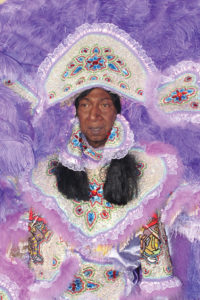Winter 2016
To the “Bead” of a Different Drum
From Nick Cave to the Creole Wild West, Shreveport embraces the art of beading
Published: December 8, 2016
Last Updated: September 25, 2018
Mardi Gras Indians are, above all, artists. Their elaborate beadwork and sewing, the intricate rhythms of their music and the closely kept traditions of their heritage are woven into the fabric of a culture unique to New Orleans.

Big Chief Howard Miller. Photo by Keith Hill.
The Creole Wild West plan to share the importance of celebrating the heritage and culture of a rare Louisiana tradition at UNSCENE!, the event series that brings national, regional and local artists to explore the Shreveport Common neighborhood. The UNSCENE! on January 28 will include a Mardi Gras Indian parade in and around Shreveport Common; an artspace exhibition of 10 hand-beaded Indian suits with headdresses, crowns, blankets and embellishments; and a beading and sewing workshop taught to the community by Big Chief Miller.
“What excites me the most about the SRAC artist residence is the chance to share the history of the Creole Wild West Mardi Gras Indians with the people of Shreveport and to bring awareness to a tradition that has been such an important part of the New Orleans culture for over 200 years,” explained Big Chief Howard. “Up until ten years ago, the Mardi Gras Indians were primarily secret societies. People did not know that our history was about slaves who found safe haven with the Native Americans and that we saw our purpose as bringing spirit and joy to hopeless people. I have shared the history of the Creole Wild West Mardi Gras Indians and our ties to Native Americans in universities across the country, including Georgetown, Auburn, Tulane, LSU and Xavier, but we have never had the opportunity to educate on the scale that we will be able to in Shreveport.”
SRAC recently hosted Nick Cave, another well-known artist whose beading and sewing has made him famous. Cave worked with the residents of Shreveport Common to bring a message to them of hope and of accepting each other “AS IS.”
“With the Creole Wild West Mardi Gras Indian artist residence, we hope to build upon the phenomenal success of beading that was developed during the Nick Cave residence, to learn new beading traditions and symbolism, and to celebrate the history and tradition that is Shreveport Common with the rest of the world,” explained Pam Atchison, SRAC Executive Director. “SRAC hopes that Big Chief Howard and his Creole Wild West Mardi Gras Indians will encourage people who currently live in and will potentially move into Shreveport Common to discover and empower the ethnic cultural traditions found within the Shreveport Common neighborhood.”
“As Told By Themselves,” a 2010 oral history of the Creole Wild West produced by the Louisiana Endowment for the Humanities.
Shreveport Common is a nine-block area that encompasses western downtown Shreveport and east Ledbetter Heights, once the region’s most significant cultural hotbed. This is where Huddie “Lead Belly” Ledbetter wrote songs like “Goodnight Irene” and where Edward Neild (architect of the Harry S. Truman Presidential Library and Museum in Independence, Missouri) designed the Scottish Rite Cathedral, B’Nai Zion Temple and the Calanthean Temple, which was developed by a group of African-American women for their husbands’ business offices. Jelly Roll Morton and Count Basie played at the Calanthean’s rooftop soirées, and Elvis Presley, Johnny Cash and Hank Williams got their start with the KWKH Louisiana Hayride at the Municipal Auditorium, also located in Shreveport Common. The Creole Wild West Mardi Gras Indians will pick up where Nick Cave left off, helping the neighbors celebrate what is authentic, creative and sustainable about their uncommon community.
The Creole Wild West Mardi Gras Indian exhibition opens at artspace on Friday, January 27, 2017, and runs through March 18, 2017. For more information, visit www.artspaceshreveport.com.

